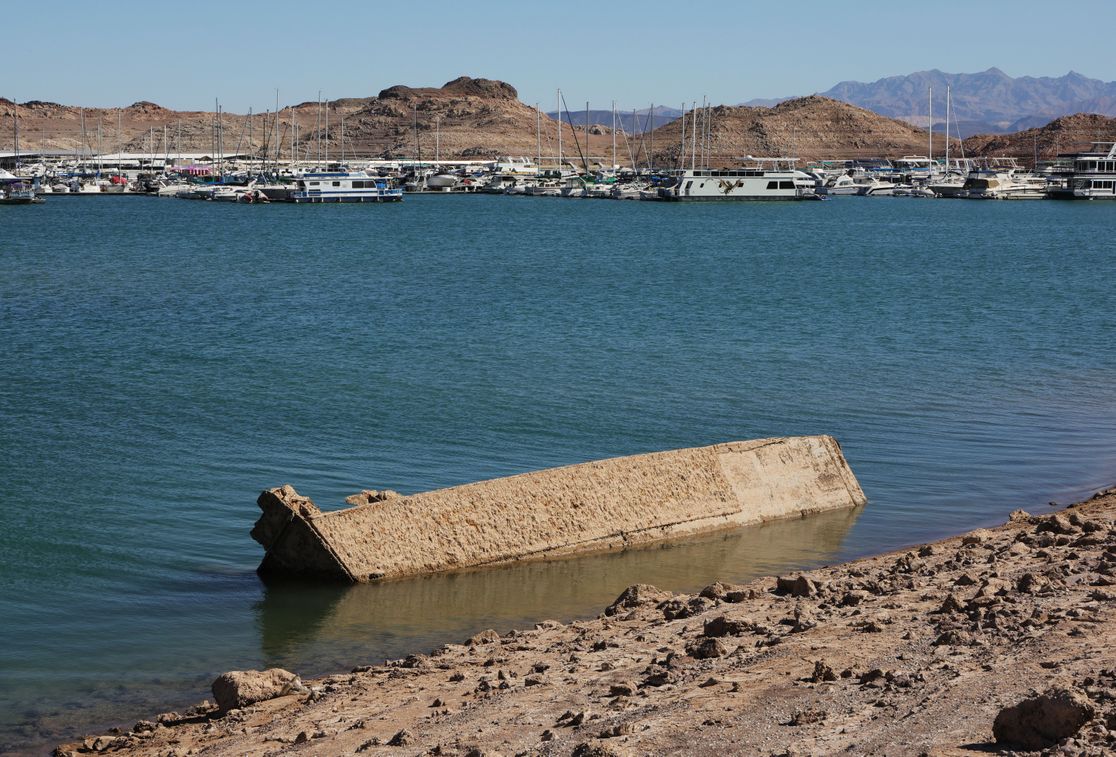| | | | | | | Presented By Salesforce | | | | Axios What's Next | | By Jennifer A. Kingson, Joann Muller and Alex Fitzpatrick · Jan 09, 2023 | | Climate change is both a blessing and a curse for archeologists and historians, Jennifer reports today, as drought, erosion and other extreme weather helps uncover big finds — while also inviting plunderers. Today's newsletter is 1,061 words ... 4 minutes. | | | | | | 1 big thing: Climate change exposes historical wonders |  | | | In downtown Baton Rouge this fall, drought exposed the wreck of a ferry called the Brookhill that plied the shores of the Mississippi in the 19th century. Image courtesy of engineering firm Forte & Tablada | | | | The job of the modern-day archaeologist is changing rapidly, as flooding, wildfires and other extreme weather-related curveballs damage or destroy excavation sites — and drought reveals long-hidden historic artifacts, Jennifer A. Kingson reports. Why it matters: Important cultural treasures and historical records are at stake as heirlooms from the past are damaged or curiosity-seekers grab souvenirs. - "From Iran to Scotland, Florida to Rapa Nui and beyond, sites are currently being eroded at an increasing rate, often before scientists can record them and assess their value," according to Antiquity magazine.
- At the same time, drought and low water levels have uncovered everything from 113-million-year-old dinosaur tracks in Texas to World War II-era boats in California's Lake Shasta and the Nevada portion of Lake Mead.
- Tourists who stumble on freshly unearthed relics are being asked to report them to authorities — and keep their distance.
Driving the news: As deadly storms pummel Northern California and record-shattering heat envelops Europe, archaeologists brace for more research sites to be washed away or degraded. - Artifacts can be damaged by many phenomena — coastal erosion, mudslides, shifting sands that bury ruins — depending on local topography.
Of note: Native American history is at stake in particular in California, where ancient villages and settlements are being washed into the sea. - "It's the coastal maritime heritage of dozens of tribes, and it's about to go away all at once," says Michael Newland, who leads the study of climate change for the Society for California Archaeology.
Meanwhile: Widespread drought is revealing previously buried treasure, as last summer's global bonanza of fresh finds proved. - Wondrous discoveries in 2022 included a "Spanish Stonehenge" of megalithic rocks, three 600-year-old Buddhist statues on the Yangtze River, and (less wondrous) dozens of explosives-laden German warships sunk in 1944 in the Danube.
- In the U.S., the catalog includes a 19th century wooden shipwreck dredged up by Hurricane Ian in Florida and a variety of vessels — both curious and mundane — in Lake Mead.
What they're saying: "In all of those places, whether it's Lake Mead or the Rhine River in Germany, people are seeing things that haven't been seen in a generation or more," says Charles "Chip" McGimsey, Louisiana's state archaeologist. - "These are random opportunities for archaeologists," he told Axios. "You can't plan on a drought."
A World War II-Era Higgins landing craft that used to be nearly 200 feet underwater in Lake Mead was photographed in July. Photo: Ethan Miller/Getty Images How it works: This fall in downtown Baton Rouge, Louisiana, a ferry called the S.S. Brookhill that sank in 1915 became a major tourist attraction after a treasure-hunter stumbled upon it while looking for trinkets in the Mississippi River. - As people flocked to see the skeleton of the 100-foot-long boat — which used to carry passengers and cargo between Baton Rouge and Port Allen, Louisiana — it thrust McGimsey and his colleagues into the spotlight.
- "Once the word got out, we had hundreds of people a day coming down to see her," McGimsey told Axios. "There were times when I'd be down there at 2 o'clock in the afternoon, and there'd be 40 to 50 people."
- Because his office is small — and typically occupied with the more mundane work of checking out cemeteries and oil spills — "it wasn't possible for us to have someone there 24/7 monitoring things and answering folks' questions," he said.
- Once the waters of the Mississippi started to rise from their historic lows, the Brookhill disappeared — and so did the visitors.
The bottom line: It's illegal to toy with a relic on state or federal land. - "Vandalism, graffiti and climbing on walls damage the resources," Mary Plumb of the National Park Service tells Axios.
Share this story. |     | | | | | | 2. Small farms move indoors |  | | | Photo illustration: Shoshana Gordon/Axios. Photo: Antonio Perez/Chicago Tribune/Tribune News Service via Getty Images | | | | Historically costly indoor hydroponic farms are becoming more accessible to small-scale U.S. farmers, Axios' Ayurella Horn-Muller reports. Why it matters: As extreme weather exacerbated by climate change hurts crop yields, some small farmers are turning to formerly out-of-reach ag-tech solutions. Catch up quick: Indoor hydroponic farms are tech-driven, weather-controlled production sites where crops are grown in nutrient solutions rather than soil. - They use less water than traditional farming methods and take up less space — and are popping up everywhere from Alabama to Hawaii.
What they're saying: Nona Yehia, CEO and co-founder of Vertical Harvest Farms, says indoor farming has long been associated with high startup and operating costs. - "As we grow as an industry, that cost is going to come down ... but I think that's going to take time," says Yehia.
- Another company, Virginia's Babylon Micro-Farms, sells indoor farming units optimized for hydroponic produce growth, with bookshelf-size units starting at about $3,500.
Read the rest. |     | | | | | | 3. 📈 Deep discounts drive record online shopping |  Data: Adobe Analytics; Chart: Axios Visuals American shoppers took advantage of big sales and rang up a record $211.7 billion in e-commerce spending in November and December, according to an Adobe Analytics report, Axios' Hope King writes. Why it matters: The results — unadjusted for inflation — reflect resilient consumer demand for holiday goods in spite of generally high inflation and a greater number of options for spending as the economy has reopened. - "At a time when consumers were dealing with elevated prices in areas such as food, gas and rent, holiday discounts were strong enough to sustain discretionary spending through the entire season," Vivek Pandya, lead analyst at Adobe Digital Insights, said in a statement.
Read the rest. |     | | | | | | A message from Salesforce | | New research reveals sales reps need a productivity overhaul | | |  | | | | The challenge: Nearly 70% of sales reps say they're overwhelmed by the number of tools. The solution: 9 out of 10 sales organizations plan to consolidate their tech stacks over the coming year so reps can spend more time selling and connecting with customers. Learn why. | | | | | | 4. 📸 Multiplayer metaverse |  | | | Photo: Alex Wong/Getty Images | | | | CES attendees try a multiplayer metaverse experience from South Korean virtual reality developer Caliverse. - The experience, which players interact with through a digital avatar, includes a virtual shopping mall, concert venue and more.
- While metaverse tech has yet to break into the mainstream, companies large and small are pouring billions into the field — and it's an especially hot category at this year's CES in Las Vegas, with plenty of demos like this one on offer.
|     | | | | | | 5. What you're saying: ChatGPT |  | | | Illustration: Sarah Grillo/Axios | | | | Are AI chatbots like ChatGPT a problem for teachers or an opportunity? Here's what What's Next readers are saying: - "Teachers should encourage students to use ChatGPT as another resource and not see it as a small-minded threat," says Thomas A. Prior. "Teachers must also challenge students to stand on their feet and back up what they have submitted."
- "Pursue other solutions, like having essays written in class or employ several of the plagiarism bots or having ChatGPT auto-watermark every response," writes Tom Korzenecki. "Better yet, encourage the use of AI technology and have students write in their own words rebuttal assignments to what ChatGPT provides."
- "ChatGPT will be to academics what the GPS is to an Uber driver," emails Jon Husted.
|     | | | | | | A message from Salesforce | | Adapting to new sales strategies | | |  | | | | The fifth edition of Salesforce's State of Sales survey can help sales organizations understand the best strategies to adjust to today's macroeconomic challenges. Why it's important: Sales strategies shifted since 2020, along with buyer expectations. Read the report. | | | | Big thanks to What's Next copy editor Amy Stern. Was this email forwarded to you? Get your daily dose of What's Next by signing up here for our free newsletter. |  | | Are you a fan of this email format? Your essential communications — to staff, clients and other stakeholders — can have the same style. Axios HQ, a powerful platform, will help you do it. | | | | | | Axios thanks our partners for supporting our newsletters.
Sponsorship has no influence on editorial content. Axios, 3100 Clarendon Blvd, Arlington VA 22201 | | | You received this email because you signed up for newsletters from Axios.
To stop receiving this newsletter, unsubscribe or manage your email preferences. | | | Was this email forwarded to you?
Sign up now to get Axios in your inbox. | | | | Follow Axios on social media:    | | | | | |











No comments:
Post a Comment